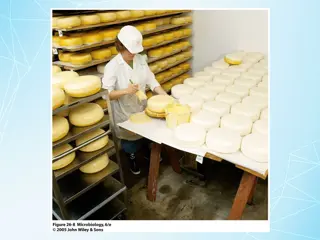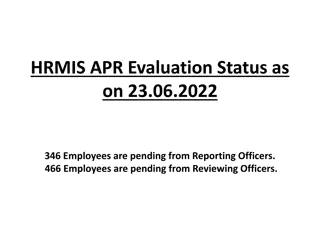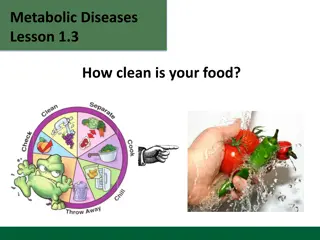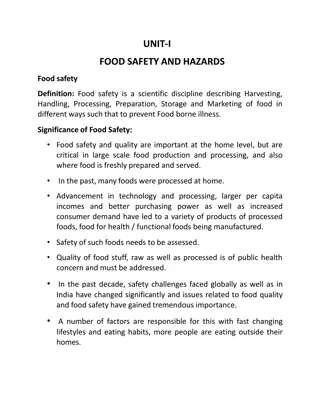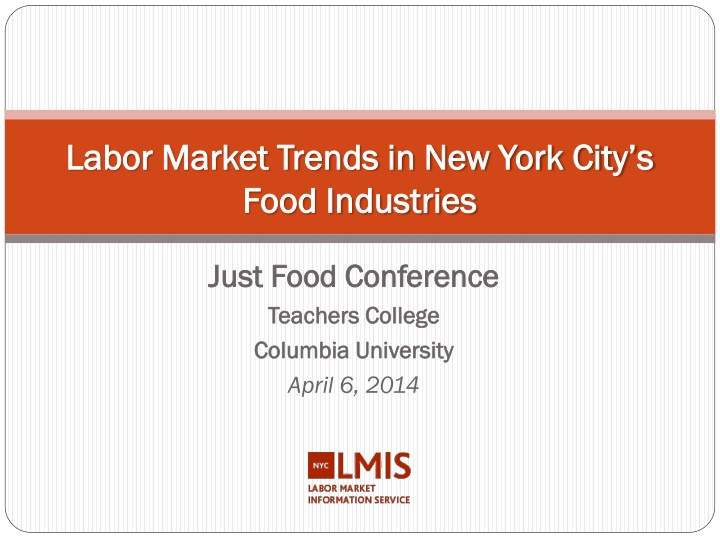
Insights into New York City's Food Industry Labor Market Trends
Explore the labor market trends in New York City's food industries, as discussed at the Just Food Conference at Teachers College, Columbia University. Learn about major industry drivers, supply chain sectors, number of firms by sector, and more, provided by the NYC Labor Market Information Service.
Uploaded on | 0 Views
Download Presentation

Please find below an Image/Link to download the presentation.
The content on the website is provided AS IS for your information and personal use only. It may not be sold, licensed, or shared on other websites without obtaining consent from the author. If you encounter any issues during the download, it is possible that the publisher has removed the file from their server.
You are allowed to download the files provided on this website for personal or commercial use, subject to the condition that they are used lawfully. All files are the property of their respective owners.
The content on the website is provided AS IS for your information and personal use only. It may not be sold, licensed, or shared on other websites without obtaining consent from the author.
E N D
Presentation Transcript
Labor Market Trends in New York Citys Labor Market Trends in New York City s Food Industries Food Industries Just Food Conference Just Food Conference Teachers College Teachers College Columbia University Columbia University April 6, 2014
The NYC Labor Market Information Service (NYCLMIS) Since our formation in 2008, our mission is to provide reliable, user-friendly labor market intelligence to education and workforce development providers and policy makers and help them make informed decisions that are aligned with the realities of the local labor market. We accomplish this by providing: Research studies Research studies: issues, industries, and populations Information tools Information tools: for providers and jobseekers Strategic consulting Strategic consulting: implications of labor market intelligence for policy and practice 2
Major Industry Drivers Major Industry Drivers Drivers? Drivers? Climate Change Sustainability Food safety Demographic shifts (e.g., aging, immigration) Chronic disease management Income Local tourism Supply chain margin squeeze Zoning and other economic development initiatives Real estate prices Affects? Affects? Food Sourcing Purchasing levels and amounts Pricing Establishing local businesses 3
Supply Supply Chain Chain Sector Sector Industry Industry Agriculture Grain and Oilseed Sugar and Confectionery Fruit and Vegetable Preserving Manufacturing Food Manufacturing Dairy Animal Slaughtering Seafood Bakeries and Tortillas Nondurable Goods Wholesale Wholesale Grocery Wholesale Grocery Stores Retail Food and Beverage Stores Specialty Food Stores Special Food Services Service Food Services 4 Restaurants and Other Eating Places
Number Number of Firms by Sector of Firms by Sector 2000 2012 20,000 20,000 18,682 18,000 18,000 16,000 16,000 14,000 14,000 12,877 12,000 12,000 10,000 10,000 9,102 8,000 8,000 7,770 6,000 6,000 4,000 4,000 2,000 2,000 1,718 1,705 1,055 49 49 971 0 0 Food Services Food Services Food Retail Food Retail Grocery Wholesale Grocery Wholesale Food Food Agriculture Agriculture Manufacturing Manufacturing SOURCE | SOURCE | NYSDOL, Quarterly Census of Employment and Wages. 5
Employment Employment by Sector by Sector 2000 2012 250,000 250,000 241,634 200,000 200,000 150,000 150,000 156,317 100,000 100,000 73,390 50,000 50,000 58,259 18,986 20,273 15,365 15,392 0 0 Restaurants Restaurants Food Retail Food Retail Grocery Wholesale Grocery Wholesale Food Manufacturing Food Manufacturing 6 SOURCE | SOURCE | NYSDOL, Quarterly NYSDOL, Quarterly Census of Employment and Wages. Census of Employment and Wages.
Average Annual Real Wages Average Annual Real Wages 2000 2012 $60,000 $60,000 $54,175 $50,000 $50,000 $51,018 $40,000 $40,000 $41,485 $33,063 $30,000 $30,000 $26,381 $24,525 $20,000 $20,000 $24,984 $26,784 $10,000 $10,000 $0 $0 Restaurants Restaurants Food Retail Food Retail Grocery Wholesale Grocery Wholesale Food Manufacturing Food Manufacturing SOURCE | SOURCE | NYCLMIS analysis of New York State Department of Labor, Quarterly Census of Employment and Wages. Adjusted using CPI-U for the New York City Metro Area, 2012 as base year. 7
Distribution of Jobs by Industry, 2012 Distribution of Jobs by Industry, 2012 (N = 352,941) (N = 352,941) MANUFACTURING MANUFACTURING GRAIN & OILSEED 0.0% SUGAR & CONFECTIONERY 0.2% FRUIT & VEGETABLE 0.3% 0.1% DAIRY ANIMAL SLAUGHTERING 0.5% 62.4% 0.1% SEAFOOD 2.9% BAKERIES & TORTILLS OTHER FOODS 0.5% 6.0% WHOLESALE WHOLESALE GROCERY WHOLESALE RETAIL RETAIL GROCERY STORES 16.5% SPECIALTY FOOD STORES FOOD SERVICES FOOD SERVICES SPECIAL FOOD SERVICES 4.1% 6.5% RESTAURANTS 8
BRONX Distribution of Employment by Distribution of Employment by Industry and Borough, 2012 Industry and Borough, 2012 BROOKLYN MANHATTAN QUEENS STATEN ISLAND 100% Food Services 80% 40% 49% 55% 59% Retail 68% 60% 83% Wholesale 33% 40% 31% 26% Manufacturing 36% 21% 20% 20% 11% 10% 6% 14% Agriculture 0% BRONX BROOKLYN MANHATTAN QUEENS STATEN ISLAND NYC SOURCE | SOURCE | NYSDOL, Quarterly Census of Employment and Wages 9
Average Annual Wage Average Annual Wage by Industry, by Industry, 2012 2012 SEAFOOD $91,135 NEW YORK CITY AVERAGE $81,641 OTHER FOODS $52,312 DAIRY $52,244 GROCERY WHOLESALE $51,765 ANIMAL SLAUGHTERING $48,578 NEW YORK CITY MEDIAN $45,970 FRUIT & VEGETABLE $38,081 GRAIN & OILSEED $34,994 SUGAR & CONFECTIONERY $33,965 SPECIALTY FOOD STORES $29,937 SPECIAL FOOD SERVICES $29,863 RESTAURANTS $24,757 BAKERIES & TORTILLS $24,521 GROCERY STORES $23,140 $0 $10,000 $20,000 $30,000 $40,000 $50,000 $60,000 $70,000 $80,000 $90,000 $100,000 SOURCE | SOURCE | NYSDOL, Averages from Quarterly Census of Employment and Wages; Median from Occupational Employment Statistics 10
What are the most common food jobs? Occupation Occupation Est. Est. Proj Proj. . Growth Growth Openings Openings per Year per Year Median Median Wage Wage Employment Employment Food prep and serving workers 52,564 18% 2,120 $18,520 Waiters and waitresses 50.276 12% 3,310 $19,540 Cashiers 28,186 9% 3,710 $18,960 Cooks, Restaurant 20,291 16% 940 $27,630 Food prep workers 13,316 4% 1,010 $25,010 Food prep and serving supervisors 12,625 12% 480 $37,760 Stock clerks and order fillers 12,156 -2% 980 $20,220 Dishwashers 11,949 9% 770 $18,830 Counter attendants 9,649 10% 940 $19,200 Dining room and cafeteria attendants 8,791 7% 520 $18,550 SOURCE | SOURCE | NYSDOL, Staffing Patterns Matrix and Occupational Employment Projections 11
Demand by Occupation (past 90 days) Occupation Occupation Volume Volume Food Supervisors 3,334 Waiters/Waitresses 2,083 Cooks, Restaurant 1,557 Chefs and Head Cooks 1,087 Combined Food Preparation and Serving Workers 875 Food Managers 917 Bakers 36 Butchers and Meatcutters 21 Food Batchmakers 14 Food Roasters 3 SOURCE | SOURCE | WANTED Analytics Hiring Demand Dashboard TM 12
Demand for Food Jobs by Industry (past 90 days) Ads Ads Industries Industries Hotels Full-service restaurants Fast-food restaurants Catering Food retail Recreation facilities Hospitals 165 111 96 90 56 45 22 SOURCE | SOURCE | WANTED Analytics Hiring Demand Dashboard TM 13
Skills, Tools and Certifications in Demand (past 90 days) Skills & Tools Skills & Tools Cutting equipment Quality control Catering sales Bilingual Steam tables Preventive maintenance Credit card machines Certifications Certifications Food Safety HACCP ServSafe OSHA Certified Executive Chef Certified Dietary Manager Registered Dietitian Certified Restaurant Manager SOURCE | SOURCE | WANTED Analytics, Talent RequirementsTM 14
Some Takeaways A range of factors affect the food supply chain, and thus food businesses, from global climate change to local zoning. Food services, by far the largest and fastest growing food sector in New York City, is concentrated in Manhattan. Food retail employment is somewhat more proportionate to population by borough. Brooklyn and Queens lead the pack with the most manufacturing jobs, 5,000 and 4,500 respectively. Brooklyn, Queens, and the Bronx have the most wholesale trade employment. Food retail and wholesale employment has grown over the decade. Employment in food manufacturing, while small, has remained stable over the past decade. Real wages have decreased over the decade, most substantially in manufacturing. Because of the industry mix in New York City, most jobs do not require a college degree. Hotels and full-service restaurants have the most online job ad volume likely because many smaller, fast-food establishments do not advertise on line. 15
Thank you! Lesley Hirsch NYC Labor Market Information Service CUNY Graduate Center 365 Fifth Avenue, Room 6202 New York, NY 10016 212.817.2031 lhirsch@gc.cuny.edu www.gc.cuny.edu/lmis

